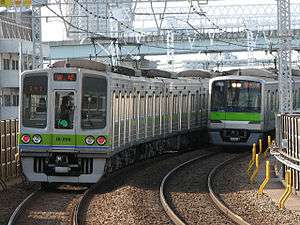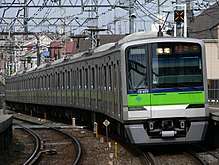Toei Shinjuku Line
| Shinjuku Line | |||
|---|---|---|---|
|
| |||
 Toei 10-000 series (left) and 10-300 series EMUs at Funabori Station | |||
| Overview | |||
| Type | Rapid transit | ||
| Locale | Tokyo, Chiba prefectures | ||
| Termini |
Shinjuku Motoyawata | ||
| Stations | 21 | ||
| Daily ridership | 701,902 (2014)[1] | ||
| Operation | |||
| Opened | December 21, 1978 | ||
| Owner | Toei Subway | ||
| Depot(s) | Ojima | ||
| Rolling stock | Toei 10-300 series, Keio 9030 series, Keio 5000 series | ||
| Technical | |||
| Line length | 23.5 km (14.6 mi) | ||
| Track gauge | 1,372 mm (4 ft 6 in) Scotch Gauge | ||
| Electrification | 1,500 V DC overhead catenary | ||
| Operating speed | 75 km/h (47 mph) | ||
| |||
The Toei Shinjuku Line (都営地下鉄新宿線 Toei Chikatetsu Shinjuku-sen) is a rapid transit line in Tokyo and Chiba Prefecture, Japan, operated by Tokyo Metropolitan Bureau of Transportation (Toei). The line runs between Motoyawata Station in Ichikawa, Chiba in the east and Shinjuku Station in the west. At Shinjuku, most trains continue as through services to Sasazuka Station on the Keiō New Line, with some services continuing to Hashimoto Station in Sagamihara, Kanagawa via the Keiō Line and the Keiō Sagamihara Line.
On maps and signboards, the line is shown in "leaf" . Stations carry the letter "S" followed by a two-digit number inside a yellow-green "chartreuse" circle (S).
Basic data
- Double-tracking: Entire line
- Railway signalling: D-ATC
Overview
Unlike all other Tokyo subway lines, which were built to 1,435 mm (4 ft 8 1⁄2 in) or 1,067 mm (3 ft 6 in), the Shinjuku line was built with a track gauge of 1,372 mm (4 ft 6 in) to allow through operations onto the Keiō network. The line was planned as Line 10 according to reports of a committee of the former Ministry of Transportation; thus the rarely used official name of the line is the "Number 10 Shinjuku Line" (10号線新宿線 Jū-gō-sen Shinjuku-sen).[2]
According to the Tokyo Metropolitan Bureau of Transportation, as of June 2009 the Shinjuku Line was the third most crowded subway line in Tokyo, at its peak running at 181% capacity between Nishi-ōjima and Sumiyoshi stations.[3]
Station list
- Express trains stop at stations marked with a circle (●), while local trains make all stops.
- Express trains run between Motoyawata Station and Hashimoto Station on the Keiō Sagamihara Line via the Keio Main Line and Keio New Line.
- On weekends and holidays, two trains run through to Takaosan-guchi Station on the Keiō Takao Line and one runs through to Tama-Dōbutsukōen Station on the Keiō Dōbutsuen Line.
| No. | Station | Japanese | Distance (km) | Express | Transfers | Location | ||
|---|---|---|---|---|---|---|---|---|
| Between stations |
From S-01 | |||||||
| Through-running to/from Hashimoto and Takaosanguchi via the | ||||||||
| S01 | Shinjuku[* 1] | 新宿 | - | 0.0 | ● |
|
Shinjuku | Tokyo |
| S02 | Shinjuku-sanchome | 新宿三丁目 | 0.8 | 0.8 | | |
| ||
| S03 | Akebonobashi | 曙橋 | 1.5 | 2.3 | | | |||
| S04 | Ichigaya | 市ケ谷 | 1.4 | 3.7 | ● |
|
Chiyoda | |
| S05 | Kudanshita | 九段下 | 1.3 | 5.0 | | |
| ||
| S06 | Jimbocho | 神保町 | 0.6 | 5.6 | ● |
| ||
| S07 | Ogawamachi | 小川町 | 0.9 | 6.5 | | |
| ||
| S08 | Iwamotocho | 岩本町 | 0.8 | 7.3 | | |
| ||
| S09 | Bakuro-yokoyama | 馬喰横山 | 0.8 | 8.1 | ● |
|
Chūō | |
| S10 | Hamacho | 浜町 | 0.6 | 8.7 | | | |||
| S11 | Morishita | 森下 | 0.8 | 9.5 | ● | E Toei Oedo Line (E-13) | Kōtō | |
| S12 | Kikukawa | 菊川 | 0.8 | 10.3 | | | Sumida | ||
| S13 | Sumiyoshi | 住吉 | 0.9 | 11.2 | | | Z Tokyo Metro Hanzomon Line (Z-12) | Kōtō | |
| S14 | Nishi-ojima | 西大島 | 1.0 | 12.2 | | | |||
| S15 | Ojima | 大島 | 0.7 | 12.9 | ● | |||
| S16 | Higashi-ojima | 東大島 | 1.2 | 14.1 | | | |||
| S17 | Funabori | 船堀 | 1.7 | 15.8 | ● | Edogawa | ||
| S18 | Ichinoe | 一之江 | 1.7 | 17.5 | | | |||
| S19 | Mizue | 瑞江 | 1.7 | 19.2 | | | |||
| S20 | Shinozaki | 篠崎 | 1.5 | 20.7 | | | |||
| S21 | Motoyawata | 本八幡 | 2.8 | 23.5 | ● |
|
Ichikawa | Chiba |
- ↑ Shinjuku Station is shared with and administrated by Keio Corporation.
Rolling stock
The Toei Shinjuku Line is served by the following types of 8-car EMUs.
Toei
- 10-300 series
- 10-300R series (until 2017)
- 10-000 series (until 2018)
Keio Corporation
- 5000 series[4]
- 9030 series
- 6030 series (until 2011)
 Toei 10-300 series EMU
Toei 10-300 series EMU- Keio 9000 series EMU
 Keio 5000 series EMU
Keio 5000 series EMU
History
- December 21, 1978: Iwamotochō – Higashi-ōjima section opens.
- March 16, 1980: Shinjuku – Iwamotochō section opens; through service onto Keiō lines begins.
- December 23, 1983: Higashi-ōjima – Funabori section opens.
- September 14, 1986: Funabori – Shinozaki section opens.
- March 19, 1989: Shinozaki – Motoyawata section opens, entire line completed.
References
- ↑ 東京都交通局ホーム - 経営情報 - 交通局の概要 - 都営地下鉄 [Tokyo Metropolitan Bureau of Transportation Home - Management Information - Overview of the Department of Transportation - Toei Subway] (in Japanese). 東京都交通局 [Tokyo Metropolitan Bureau of Transportation]. April 1, 2015. Retrieved 2016-01-17.
- ↑ Tetsudō Yōran (ja:鉄道要覧), annual report
- ↑ Metropolis, "Commute", June 12, 2009, p. 07. Capacity is defined as all passengers having a seat or a strap or door railing to hold on to.
- ↑ ""京王ライナー"の運転開始|鉄道ニュース|2018年2月23日掲載|鉄道ファン・railf.jp". 鉄道ファン・railf.jp (in Japanese). Retrieved 2018-03-11.
External links
| Wikimedia Commons has media related to Toei Shinjuku Line. |